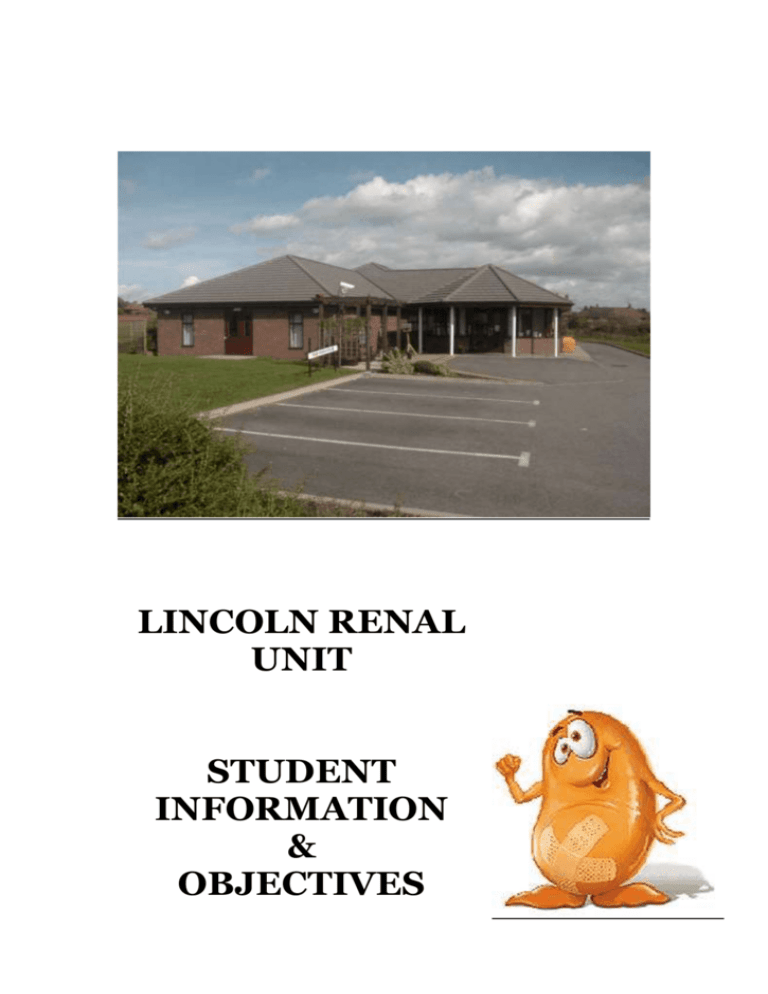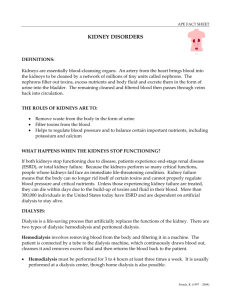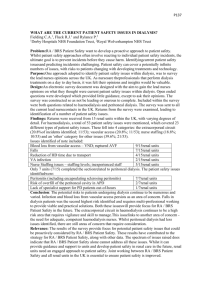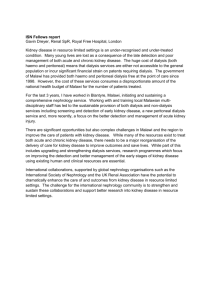(renal) failure
advertisement

LINCOLN RENAL UNIT STUDENT INFORMATION & OBJECTIVES ANATOMY & PHYSIOLOGY OF THE KIDNEY We have two kidneys that lie behind the peritoneum, either side of the vertebral column. They extend from the e level of the 12 th thoracic vertebra to the 3rd lumber vertebra. The right kidney is usually lower that the left, due to the liver on that side. Both kidneys are bean-shaped organs, about 11cm long, 6 cm wide and 3 cm thick. They also weigh about 150g. They are embedded in, and held in position by a mass of fat. Position of the kidneys in the body On the concave surface of the kidneys lies the hilus, from which the ureter and main blood vessels and nerves access the kidney. The ureter runs from each kidney to the bladder in the lower part of the abdomen. The renal artery branches off from the aorta and brings oxygenated blood to them. The renal vein takes deoxygenated blood away from the kidneys to the vena Cava. If you were to slice the kidney in half, the kidney reveals two distinct regions; a dark outer region, the cortex, which is covered by a fibrous capsule, and a pale inner region called the medulla. The cortex contains the filtering and re-absorption components of the nephrons, whilst the medulla contains the concentrating and diluting components of the nephrons and a system of collecting ducts, which funnel he urine into the pelvis at the heart of the medulla, where it moves down the ureter into the bladder. The nephron is the functional unit of the kidney and each kidney contains about 1 million nephrons. The basic function of the nephron is to clean and clear the blood plasma of unwanted substances as it passes through the kidney. The unique structure of the nephron contains 5 distinct components, each performing a distinct process. The Nephron The Bowman’s capsule – forming a blind ending capsule around the knot of capillaries called the glomerulus (the site of filtration). The Proximal Convoluted Tubule – (the site of “bulk phase” reabsorption and some secretion). The Loop of Henle (where the concentration and filtration of urine mainly occurs). The Distal Convoluted Tubule – (the site of “fine tuning” re-absorption and more secretion). The Collecting Duct – (also important for the concentration of urine and for carrying urine into the renal pelvis). The blood arrives through the renal artery, it is distributed through the tiny breaching arterioles into millions of capillaries, which are coiled and intertwined in a ball- shaped mass (glomerulus). As the blood passes through these blood vessels, water, salts and waste products leak through the walls into capsule, to produce a plasma-like mixture that drains into the first of a series of tiny tubes. As fluid flows into the first tubule (the proximal convoluted tube), glucose, amino acids, vitamins and salt are absorbed back into the bloodstream to circulate around the body. The remaining fluid trickles into the second tubule, loop of Henle. here the re-absorption of water and salts continues so that, by the time the fluid reaches the last tubule, the distal convoluted tubule, all that is needed is a little fine tuning of salt content before urine drips into a collecting tube ready for transport to the bladder, through the ureter. FUNCTIONS OF THE KIDNEY Regulation of water and electrolyte balance Regulation of acid base balance regulation of blood pressure Regulation of red blood cell production (erythopoeitin) Regulation of calcium absorption Removal of end products of metabolism Removal of foreign chemicals NORMAL VALUES (mmol/L) Sodium Na+ 135-145 Potassium K+ 3.5-5.0 Chloride Cl 96-106 HC03 23-29 Bicarbonate Urea 2.5-7.0 Creatinine 60-120 Osmalality 280-295 Calcium Ca++ 2.12-2.62 Phosphate PO4 0.8-1.4 Albumin 35-50 Alkaline Phos 20-90 Aluminium 0.07-0.55 WHAT IS KIDNEY(RENAL) FAILURE Kidney failure is a state in which kidney function is no longer able to maintain the body chemistry within normal limits. The function of the kidneys is, among other things, to get rid of waste products, which result from the body’s metabolism . If the kidney function fails, the waste products accumulate in the blood and the body. WHAT CAUSES KIDNEY (RENAL) FAILURE Renal failure can happen rapidly, over days, weeks or months (Acute renal Failure ARF) or slowly over a periods of years (Chronic Renal Failure CRF), eventually leading to End Stage Renal Failure (ESRF). ACUTE RENAL FAILURE (ARF) This may occur with any serious illness or operation, particularly those complicated by severe infection. If the blood supply to the kidneys is reduced considerably from blood loss, a fall in blood pressure, severe dehydration or lack of salt, then the kidneys may be damaged. If this problem lasts long enough, there can be permanent damage to the kidney tissue. Sudden blockage to the drainage of urine from the kidney cause damage. A kidney stone is a cause of this. Acute kidney damage can occur as a rare side effect of some medications and other rare conditions. CHRONIC RENAL FAILURE (CRF) CRF occurs when the kidneys are progressively and irreversibly destroyed over a period of time. The most common causes in CRF are Glomerulonephritis (GN), Pyelonephritis, and Polycycstic kidney disease. It may also arise as a complication of high blood pressure, diabetes mellitus and many other diseases. Infections, nephrotoxic drugs and chronic obstruction of the urinary tract are additional causes. WHAT ARE THE SYMPTOMS ARF Here the symptoms are largely those of the condition causing kidney failure, such as: Blood loss, causing a drop in blood pressure Vomiting and Diarrhoeas, causing dehydration Crush injuries, if large amount of muscle is damaged there is a release of protein substance, which are harmful to the kidneys. CRF The damage to the kidneys is usually ‘silent’ and not noticed at an early stage. It may be discovered incidentally from blood or urine tests done for other reasons. High blood pressure very commonly occurs with it. Symptoms are uncommon unless kidney failure is far advanced, when any of the following may be present: Tiredness itching Loss of appetite Nausea & Vomiting Breathlessness Fluid retention, shown as ankle oedema (swelling) Weakness HOW IS RENAL FAILURE TREATED ARF Most causes of renal failure can be treated and the kidney function will return to normal with time. Replacement of the kidney function by dialysis may be necessary until kidney function has returned. CRF Chronic kidney damage is usually not reversible and if extensive, the kidneys may eventually fail completely. Dialysis or kidney transplantation will then become necessary. Chronic kidney failure is therefore a serious condition which needs urgent attention when it is diagnosed but the kidney damage is usually ‘silent’ and not noticed at an early stage. Occasionally it may be possible to identify and treat the cause of the renal failure itself. More commonly the treatment has to be non-specific. In all cases, careful blood pressure control is extremely important in slowing the progress of kidney failure. Changes in diet may be necessary and include a reduction in salt intake, avoiding foods containing a lot of potassium and reduction in protein and phosphate in the diet. Anaemia commonly results from CRF but can be easily treated with injection of the hormone Erythropoietin. Supplements of vitamin D help prevent a bone condition which can occur in CRF. It is important to avoid certain medications (such as anti-inflammatory painkillers) which may worsen kidney function. END STAGE RENAL FAILURE In end stage renal failure, the maintenance of life can be ensured by dialysis (Haemodialysis or Continuous Ambulatory Peritoneal Dialysis) or Renal transplantation. HAEMODIALYSIS Haemodialysis is a procedure that cleans and filters the blood. It rids the body of harmful wastes and extra salts and fluids. It also controls blood pressure and helps the body keep proper balance of chemicals such as potassium, sodium and urea. Haemodialysis uses a dialyser or special filter to clean the blood. The dialyser connects to a machine. During treatment, the blood travels through tubes into the dialyser. The dialyser filters out wastes and extra fluids. Then the newly cleaned blood flows through another set of tubes and back into the body. Before the first treatment, an access to the bloodstream must be made. The access provides a way for blood to be carried from the body to the dialysis machine and then back into the body. The access can be internal (inside the body-usually under the skin known as arterio-venous fistula AVF) or external (outside the body-usually a vascath temporary or permcath permanent). Haemodialysis can be done at home or at the dialysis unit. At the unit nurses perform the treatment. At home the patient will perform haemodialysis with the help of a partner, usually a family member or friend. If the patient decides to do home dialysis, the patient and their partner will receive special training. Haemodialysis is usually done three times a week. Each treatment lasts from 2-4 hours. During treatment the patient can read, write sleep, talk or watch TV. POSSIBLE COMPLICATIONS Side effects can be caused by rapid changes in the body’s fluid and chemical balance during treatment. Muscle cramps and hypotension are two common side effects. Hypotension, a sudden drop in blood pressure, can make the patient feel weak, dizzy or sick to their stomach. It usually takes a few months to adjust to Haemodialysis. The patient can avoid many side effects if they follow the proper diet and take their medicines as directed. Haemodialysis and proper diet help reduce the waste that build up in the blood. The patient should remember to : Watch the amount of potassium they eat. potassium is a mineral found in salt substitutes, some fruits, vegetables, milk, chocolate and nuts. Too much or too little potassium can be harmful to the heart limit how much they drink. Fluids build up quickly in the body when the kidneys are not working. Too much fluid makes the tissues swell. It can also cause high blood pressure and heart trouble. Avoid salt. Salty foods make you thirsty and cause the body to hold water. FORMATION OF ARTERIO-VENOUS FISTULA (AVF) Arterio-venous fistula is the long term access of choice since it involves the patient’s own blood vessels and, as such, is unlikely to be a source of infection (Williams et al 1991). An AVF is formed by a surgical subcutaneous anastomosis of an artery to a vein. Because the vein is not adapted tot he high pressure associated with arterial circulation, it swells and its walls become thicker, making the insertion of two wide –bore needles easier. It takes 6-8 weeks for a fistula to mature before it can be used for the first time. TYPES OF FISTULAS There are three types of fistulas performed, mainly on the patient’s nondominant arm. Radio-Cephalic AVF – most commonly done Brachio-Cephalic AVF Brachio-Basillic AVF PERCUTANEOUS ACCESS Percutaneous access is the term used to describe the insertion on a cannula or catheter into a major vein. Permanent tunnelled percutaneous catheter HAEMOGLOBIN (HB) Normal Levels - 13-17mmol/s (males) - 12-15.5mmol/s (females) Anaemia when Hb below 10 Signs and Symptoms - tiredness - loss of stamina - short of breath - anorexia Causes and treatment 1. Uremic toxins – dialysis 2. Nutritional defiencies diet substitutes 3. Blood loss residual blood in lines blood test anticoagulation occult blood UREA Normal levels 2.5-6.4mmol/L Urea is an end product of protein metabolism Formed in the liver and excreted by the kidneys Urea rises in - renal failure - excessive protein intake - infection - dehydration - certain drugs CREATININE Normal values 70-120mmol/L Creatinine is produced by the breakdown of creatinine phosphate in muscle and is excreted by the kidneys reliable indicator of kidney malfunction as it is unaffected by - tissue damage - infection - protein intake Creatinine naturally increases with age SODIUM (Na+) Normal levels 135-145 mmol/L Provided by diet regulated and excreted by kidneys Functions - Maintains osmotic pressure - acid-base balance - aids transmission of nerve impulses Hyponatremia <135mmol/L - Excess body fluid - burns - diarrhoea/vomiting Hypernatremia >145 mmol/L - dehydration - diabetes insipidus Profiling in dialysis CALCIUM (Ca+) Normal levels 2.1-2.6 mmol/L Provided by diet an excreted by kidneys the main mineral in bone responsible for - muscle contraction - cardiac function - blood clotting Hypercalcaemia - high levels precipitate in soft tissues - red itchy eyes Hypocalcaemia - Chronic Renal Failure where phosphate excretion is high - Excess release of PTH - Vitamin D POTASSIUM (K+) Normal levels 3.5-5 mmol/L Provided by diet and extracted by kidneys Functions - nerve conduction - cardiac output Hypokalaemia <3.5 mmol/L - Vomiting/diarrhoea - diuretic usage - IV fluid without added K+ Can cause cardiac arrhythmias - requires prompt action PHOSPHATE (PO4) Normal levels 0.8-1.5 mmol/L Provided by diet and execrated by kidneys Phosphate and calcium work together - when Ca up then PO4 is down - when Ca down the PO4 is up Patient complains of pruritis Treatment - more effective dialysis - phosphate binders which must be taken with food PERITONEAL DIALYSIS Peritoneal dialysis is a form of renal replacement therapy (RRT) which takes place within the patient’s body using the peritoneum as the dialysis membrane. The peritoneum is a natural lining and has two layers. The visceral peritoneum lines the internal abdominal organs and the parietal peritoneum lines the inside of the abdominal wall. The space within these two layers is called the peritoneal cavity. It is within this space that the peritoneal dialysis fluid is placed for dialysis to occur. The peritoneum contains many blood vessels called peritoneal capillaries, it also has small pores which allow molecules of a certain size to pass through, thus allowing toxins and water to transport from the blood stream, through the peritoneal membrane and into the peritoneal fluid. THE MAIN PRINCIPLES OF PERITONEAL DIALYSIS Peritoneal dialysis involves the movement and transport of solutes and water across a membrane, this occurs by: DIFFUSION: toxins diffuse from the peritoneal capillaries down the concentration gradient into the peritoneal dialysis fluid. Glucose, lactate and some calcium diffuses in the opposite direction from the peritoneal dialysis fluid into the patient’s bloodstream. ULTRAFILTRATION: this occurs by osmosis due to the hyperosmolarity of the peritoneal dialysis fluid which contains glucose. This draws excess fluid from the blood stream. The amount of water removal will depend on the strength of the glucose in the peritoneal dialysis fluid, HOW DOES IT WORK? A catheter is surgically inserted through the abdominal wall and sits in the peritoneal cavity. It is a permanent plastic tube about the width of a pencil and is generally placed just below and to the side of the navel. After insertion it is left for 2-4 weeks before use for healing to take place. The place where the tube comes out of the abdomen is call the exit site. PERITONEAL DIALYSIS COMPRISES OF A SEQUENCE, COMMONLY CALLED AN EXCHANGE: THE DRAIN: used peritoneal dialysis fluid (the effluent) is drained out of the peritoneal cavity by gravity into an empty drainage bag and later discarded down the toilet. THE FILL: warm peritoneal dialysis fluid is drained into the peritoneal cavity, on average this is 2 litres in volume. The catheter is then capped off. THE DWELL: the peritoneal dialysis fluid is left inside the body for several hours for the dialysis to take place. The cycle is then repeated. TYPES OF PERITONEAL DIALYSIS CAPD: Continuous ambulatory peritoneal dialysis. This is a manual exchange procedure where after draining out used fluid, new warm PD fluid is placed in the peritoneal cavity and left for 4-6 hours (longer overnight) for dialysis to occur. This used fluid is then drained out and replaced by new fluid. In CAPD there is always fluid in the peritoneal cavity and patients will generally do 4 exchanges a day. APD: Automated peritoneal dialysis. Generally used overnight, a patient connects to a machine which consists of interconnecting lines and several bags of PD fluid. It is programmed to perform several exchanges while the patient sleeps. COMPLICATIONS OF PERITONEAL DIALYSIS PERITONITIS. This is inflammation and infection of the peritoneum which can be mild or severe. It can occur by poor technique and contamination of the patients catheter but can also occur by bacteria entering the catheter or from inside the body. Patients are trained to look for signs of peritonitis by inspecting their effluent (used peritoneal fluid) and checking that it is clear and not cloudy. If it is cloudy they have to go to hospital and commence antibiotic therapy while their effluent is sent for analysis. It is very important to treat peritonitis promptly as it can damage the peritoneum and therefore lessen the success of peritoneal dialysis for the future. If infections are severe then some patients will have to rest their peritoneum and have temporary haemodialysis. They may have to have their PD catheter removed, hopefully they can have another one inserted at a later date. EXIT SITE INFECTIONS The exit site is the area where the catheter comes out of the abdomen, Patients are taught how to clean around their exit site to prevent infection. It is also very important to keep the catheter securely taped to prevent any trauma occurring. Exit site infections are generally treated with a course of oral antibiotics. If an exit site infection is not treated then it can travel down the PD catheter and cause a tunnel infection which can be severe. The catheter may have to be removed and replaced. Other complications Fluid in the peritoneal cavity causes an increase in intra-abdominal pressure. This can lead to hernias and leaks. If either of these problems occur then patients may need temporary haemodialysis to allow the hernia to be repaired or for the leak to seal. Peritoneal dialysis patients have to be careful when lifting and are encouraged to do exercises to protect their backs from strain. Points to consider about peritoneal dialysis It is a home based therapy rather than hospital based treatment. Patients therefore have more control over their disease and can maintain their independence They do have to dialyse everyday on CAPD or overnight if on the APD machine, however times can be flexible. Because patients have more dialysis their diet and fluid intake is less restrictive than patients on haemodialysis. Storage space is needed for supplies and a clean area with a washable surface to carry out exchanges. Infection is a risk so cleanliness is very important.



